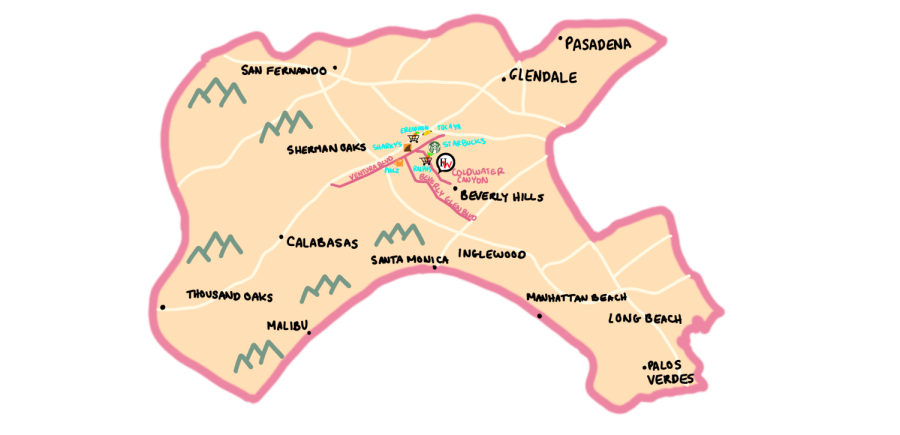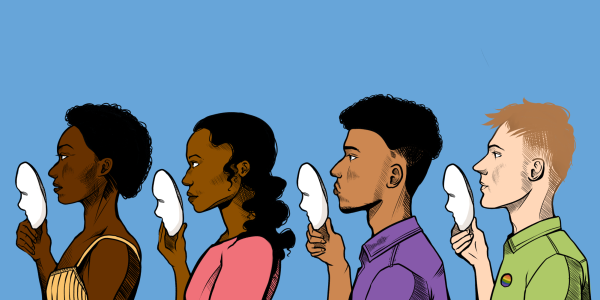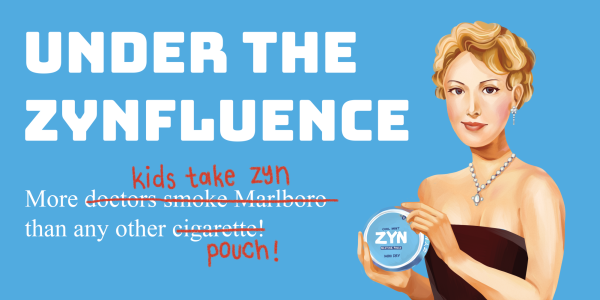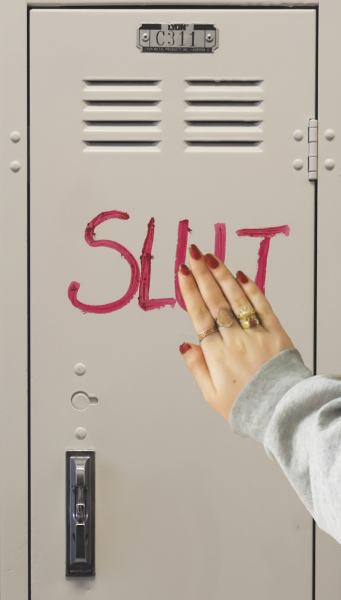Going the Extra Mile
An illustration depicts a map of where different students live in Los Angeles.
February 8, 2023
It is 5:45 in the morning, and Bella Adishian’s ’24 alarm rings through her pitch-black room. She quickly throws on her clothes, brushes her teeth, eats breakfast and leaves the house by 6:15 a.m. Adishian said her bus ride from Manhattan Beach takes her an hour and 20 minutes in the morning — and as long as two hours back in the afternoon. She’s not alone: According to a Chronicle Poll, 10% of students have commute times above an hour. Because of her long drive, Adishian said she is forced to maximize her time.
“I try to utilize my free block and lunch and conference times to get my homework done, so I can have more time later in the night to do other things and get ahead. By having a strict schedule every day from having to wake up early, I think I’ve become better at managing my time and a more effective studier. Then, I have to try and go to bed early and do it all over again.”
Adishian said although she experienced difficulties adjusting to the school’s academic rigor after previously attending her local public school, she wanted to surround herself with an environment with like-minded people despite the logistical sacrifice.
“I had the option to go to a public school that was 10 minutes away from my house,” Adishian said. “I think I lacked certain experience, which made it more difficult to succeed at Harvard-Westlake, but I definitely saw myself growing from over the last few years by becoming a more efficient and well rounded person. Despite having a lot of individuals that really do and excel in academics, Manhattan Beach has a stereotypical beach and relaxed kind of vibe, putting school maybe as a second priority. I still really value my community, but there aren’t many schools like ours, which is why I chose to go here.”
On the bus, Adishian said she does not feel judged for using the long drive as an opportunity to sleep more.
“When I head to school, I either do work on the bus, or I’ll sleep to get those extra hours,” Adishian said. “Sleeping on the bus, especially on that hour is actually quite normalized because everyone is either too tired to care or is just minding their own business. No one is judging you.”
Like Adishian, Math Teacher Kanwaljit Kochar lives far from the school in La Habra, a city in Orange County. Kochar said his average commute to school is about 2 hours. To avoid traffic, he said he has adopted an intense morning routine.
“I get up at three a.m. to get ready and about a quarter to four o’clock, I’ll leave the house,” Kochar said. “Then, it will take me about 40 minutes to get here. The reason I come early is to avoid traffic and get work done here in the morning. So, I’m usually here by a quarter to five and five o’clock every morning. My job is to make coffee in the morning. I definitely need it.”
Kochar said that he often works later hours in order to optimize the time it takes for him to drive home.
“When I’m here with students after school, I will usually stay and work here and leave at seven when the traffic goes down,” Kochar said. “There have definitely been times when I’ve gone home and slept for 3 or 4 hours andthen come back to school. So, that would be about 14 to 15 hours at school. So, I definitely am sympathetic to students with long commute times.”
Students reflect on how they get to campus
Similarly, for Alex Lee ’24, sleep is extremely important, yet scarce. Lee lives in Koreatown –– an hour’s drive from school with traffic –– and said he tries to maximize the amount of sleep he gets on late start by Ubering to school instead of taking the bus.
“I will usually Uber to school on late start since the bus leaves so early,” Lee said. “ I just bite the bullet and get an Uber in order to actually sleep in and reap the benefits of school starting later. It is a little bit expensive, and I feel fortunate to be able to do this.”
Despite this, Lee said his main method of getting around is walking, since he said the public transportation in his neighborhood is poorly organized.
“Whenever I need to get somewhere that’s more or less inwalking distance, I usually walk. But if it’s longer, I usually need to figure out a ride. I’ve tried public transportation, but Koreatown doesn’t really have much of a transit system. There is only one line that is semi-useful, which goes to Burbank. That isn’t close enough to school, so the school bus, Uber and my mom driving me are my main options.”
Unlike Lee, Chance Krenzer ’25 lives within walking distance to school. The Chronicle Poll revealed that 52% of students live less than 30 minutes away. 12 students fall into the same group as Krezner and have a commute of less than 10 minutes. Krezner said when he does not drive to school, he rides his bike.
“If I want to bike to school, I usually wake up 15 minutes earlier,” Krenzer said. “Sometimes it is just easier, so I don’t [need to have a whole production of] waking up my parents and asking them to sit next to me while I drive. It’s refreshing to start my day like this and super easy too.”
Students and faculty discuss how their family’s finances affect their school life.
Lee said he does not drive because it is not financially viable for his family. Though he occasionally Ubers to school on late start days, he said he still doesn’t feel the same amount of privellegeas his peers who are able to drive.
“I don’t feel that bad when I use uber because I would feel more privileged if my parents were able to get me a car and consistently fuel it with gas,” Lee said. “I think a lot of kids at school have nice cars with parents that are able to shell out a bunch of money for them . My mom is unable to get me a car, so I don’t think I feel that same amount of privilege as other people at school. Obviously, I am extremely fortunate, especially compared to my friends who go to public school that bike everywhere, but not as much compared to students at Harvard-Westlake.”
Regardless of the differences between his classmates, Lee said that the school’s social structure is not as defined by class or wealth as his previous school was.
“I think Harvard-Westlake is sort of unique because the social scene is not really divided economically,” Lee said. “I’ve been to public schools all my life before this, and it’s very clear to see the economic disparities and how they divide up friend groups. At Harvard-Westlake, sure, there might be a difference between a Bel-Air house and a nice house in Burbank or Calabasas, but it doesn’t really matter. I don’t think there’s a genuine enough financial difference between those two groups in society that it’s worth forming groups over. No one, if not a very few amount of people, at Harvard Westlake are truly struggling financially in terms of paying bills or for food.”
Head of Financial Aid and Interim Head of Admissions Greg Gonzalez said the majority of students receiving financial aid integrate well and feel welcome in the school community despite coming from a variety of areas with long drives.
“From what I know, students generally say they feel welcome,” Gonzalez said. “We’ve had students help us at open houses and financial aid online awareness nights, who have openly discussed their status on financial aid and report that they feel welcome and supported. A fifth of our students are on aid. If they don’t feel welcome, I hope that they work with somebody in the community to help them but in general, I feel like people don’t view it as a negative characteristic about somebody.”
According to Gonzalez, the amount of aid given to each family is customizable to their precise situation, which accounts for commute costs as well.
“We look at the general cost of living, families also individually report their monthly expenses, part of which is transportation in general,” Gonzalez said. “It’s considered by what a family submits in their application. We don’t have a dedicated table for commute times or distances and it’s not like there’s a special gas consideration. However, there is a cost of living consideration, which families individually report and we make grants in accordance with those. Ultimately, people go through this because of what a special place Harvard-Westlake is.”
Gonzalez said financial aid expands geographic representation diversity at school and makes the application a lot more accessible and also competitive.
“Financial aid allows us to broaden our applicant pool and by doing so, we broaden the geographic area that we serve,” Gonzalez said. “I wish we had enough aid to be to accept every qualified student, who applies for aid in admission. [Appling for aid] is a slightly more competitive pool. Just like the regular admissions limit the amount of spots, financial aid is also limited.”
Kochar said he tolerates the long hours from his commute because he enjoys his job and being part of the school community.
“Once I started here, I just couldn’t imagine working anywhere else,” Kochar said. “I would rather deal with the commute than leave the school. I love this place.”









































